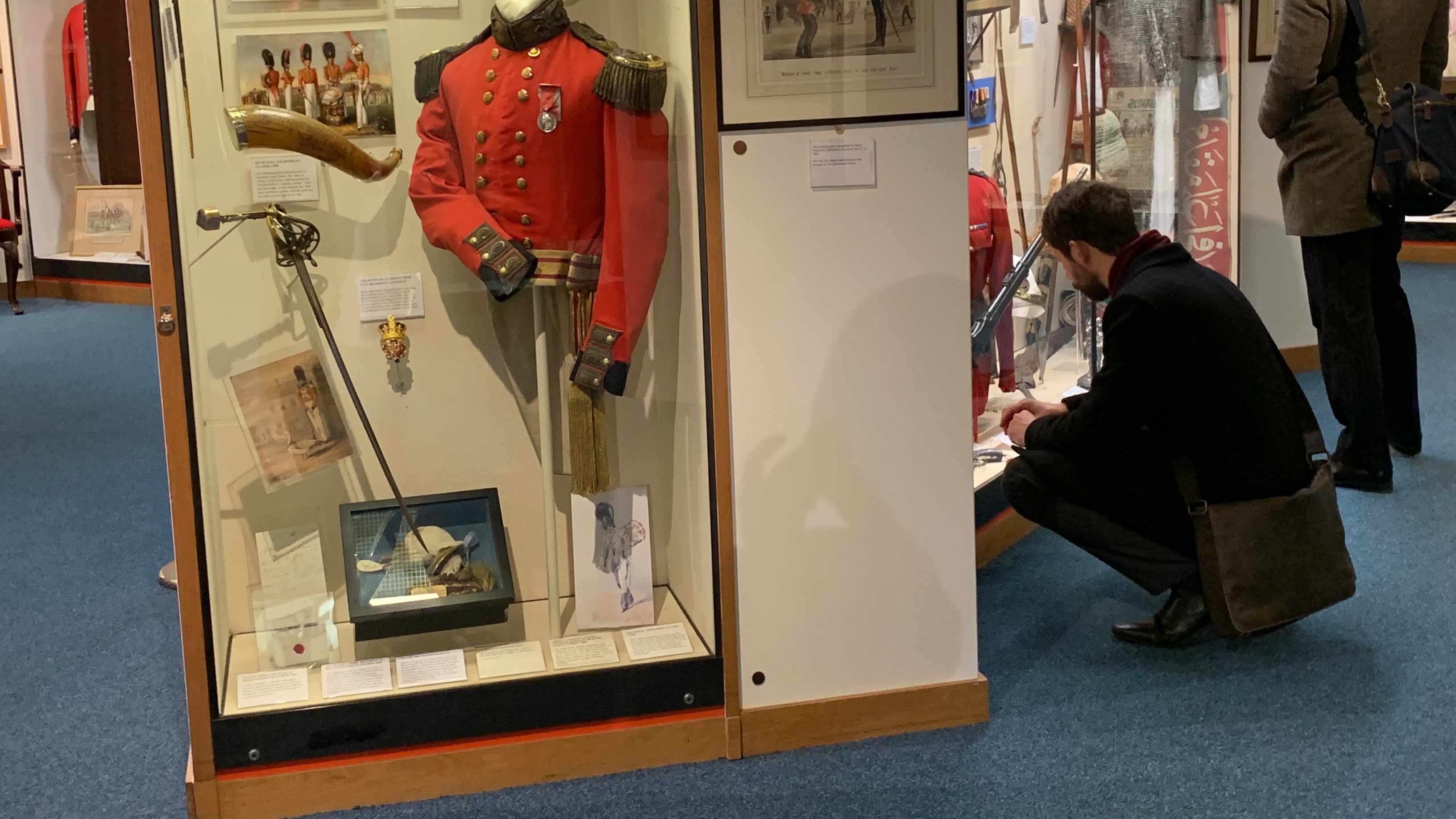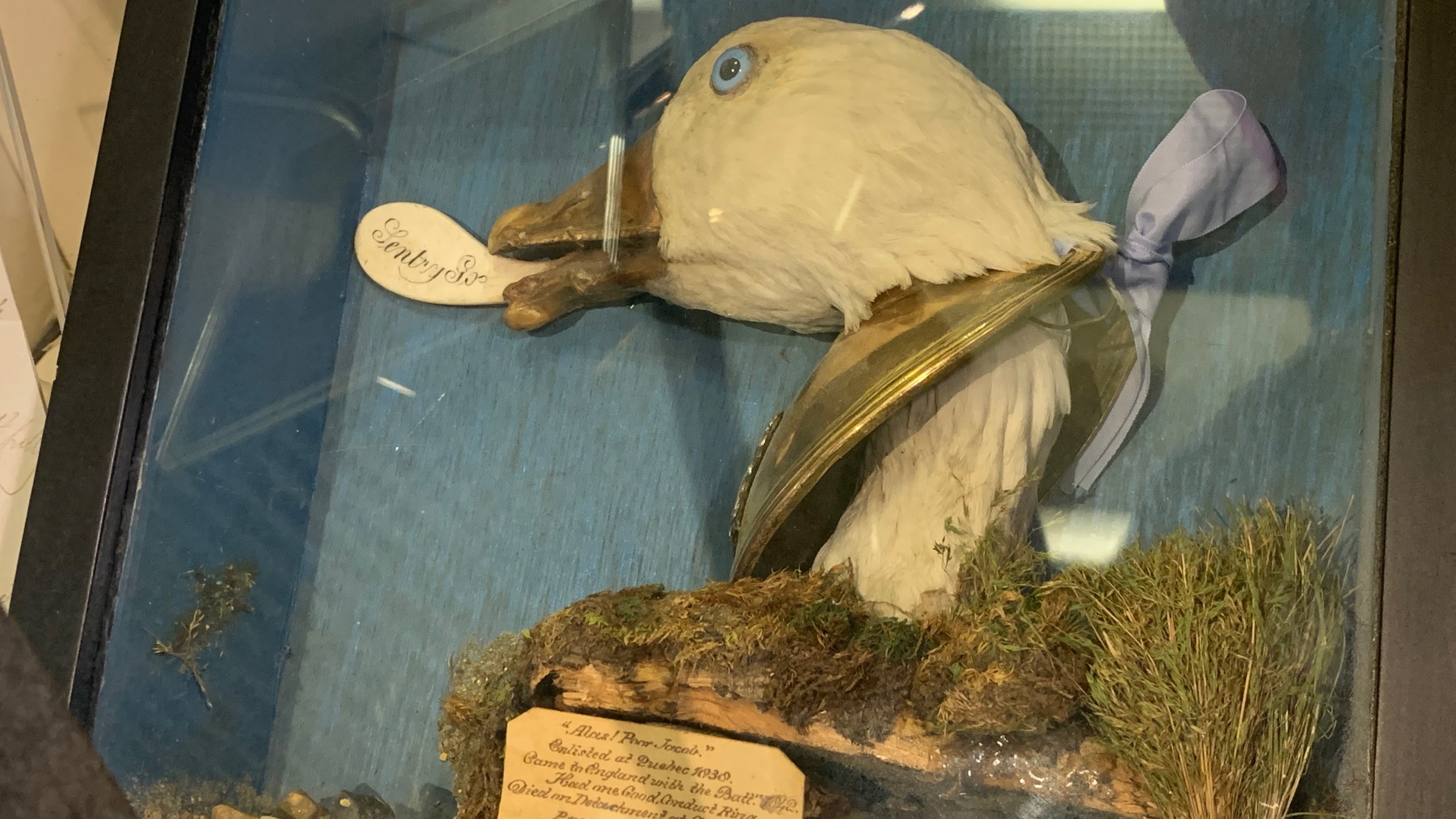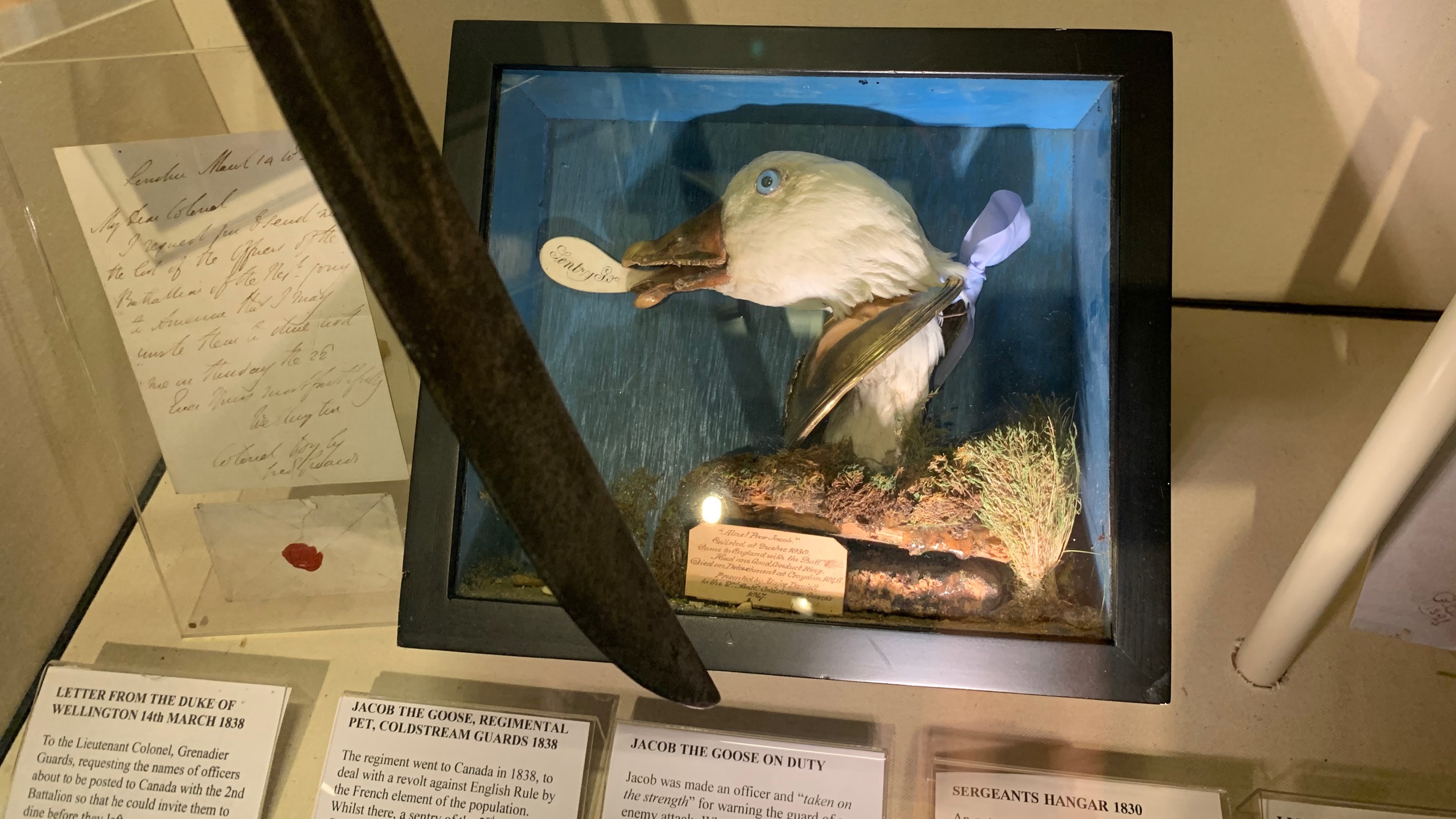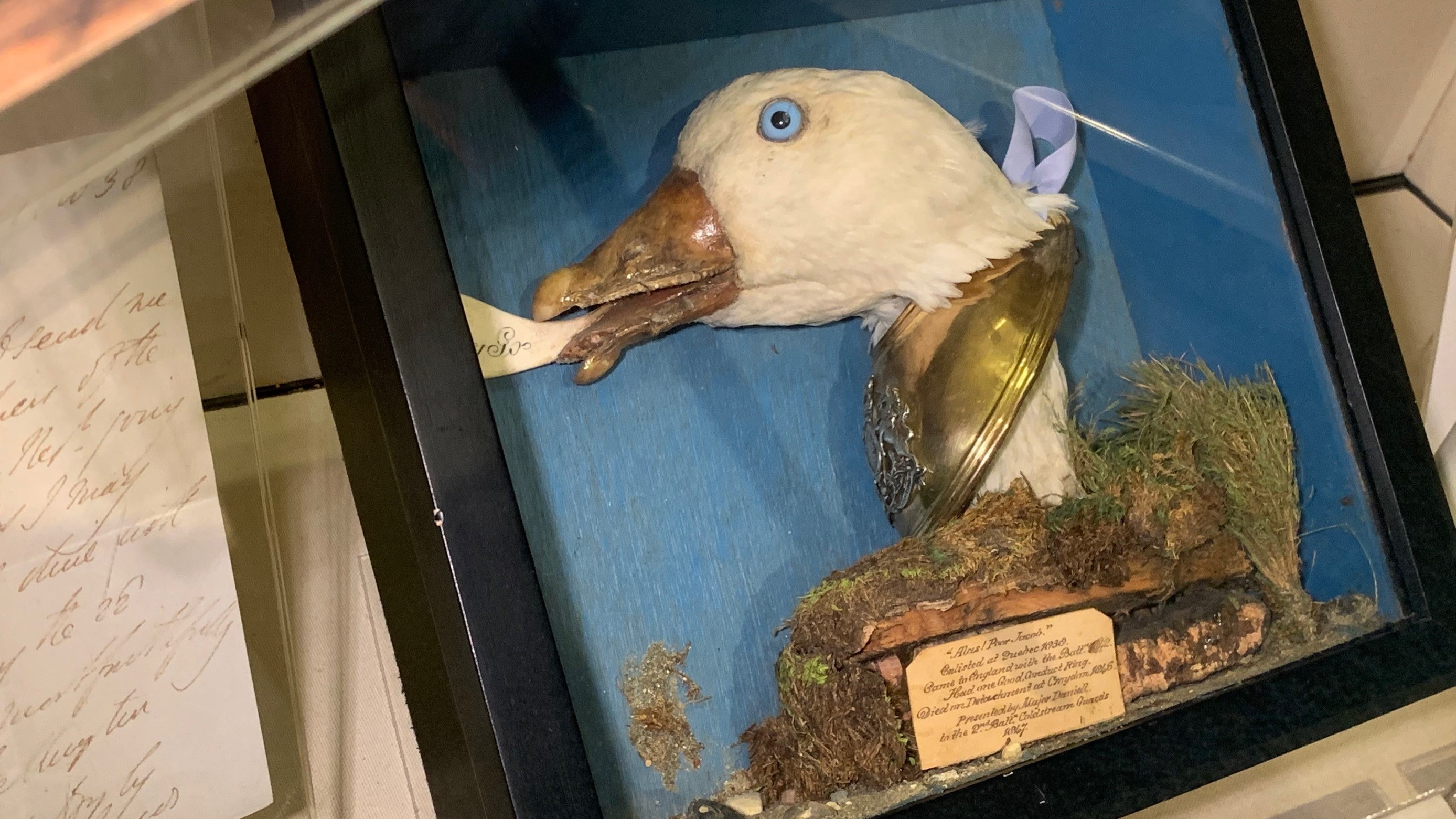The dead-famous Goose that saved Christmas for the Coldstream Guards in Canada
This is the story about a once-famous goose – yes, a real goose – that became an Army officer and saved Christmas for the British military serving overseas in Canada.
It was in 1838 that the 2nd Battalion Coldstream Guards were deployed to Quebec – once a former British colony in Canada – due to an uprising of French Canadians, who tried to arm and organise the population in preparation for open rebellion against British rule.
It was during the regiment's time garrisoned there, that Jacob the Goose came to fame.

There, a soldier on sentry duty saw a goose being attacked by a fox and, wanting to save the goose but not wanting to alert the garrison by firing a shot, the sentry used his bayonet to save the goose's life.
The story goes that the goose was very grateful to the sentry and spent much of his waking days standing sentry with the soldiers on duty, marching back and forth with the guardsmen, keeping watch over the regiment.
Sometime later, during winter, Jacob managed to alert one of the sentries of an approaching group of French rebels, preparing to launch an attack on the garrison.
They were able to get close due to heavy snow shielding the noise of their movement toward the unsuspecting sentry.
Eagle-eyed Jacob managed to thwart the attackers by flying at them aggressively, which provided enough time for the sentry to shoot and bayonet the advancing men.

When word spread of Jacob's heroic actions that day, officers of the regiment presented him with a gold gorget, which he wore for the remainder of his days. He was also awarded a good conduct ring.
From that moment onwards, Jacob was seen as a bit of a hero among the troops and he managed to secure his fate as being a well-respected member of the regiment and was also made an officer and 'taken on strength' – actually recorded on the battalion's nominal roll.
Upon the regiment's successful deployment and return to England for Christmas leave in 1842, the now highly-decorated and respected Jacob took up sentry duties outside the regiment's Portman Street Barracks in London.
Soldiers of the regiment were under no illusion that Jacob had undoubtedly saved the day and potentially many lives, just before they were due to return home for Christmas leave that year.
Even the Duke of Wellington is said to have visited Jacob and expressed his admiration and appreciation of Jacob's devotion to duty.
Jacob's neck and head is, to this day, still preserved in a glass display case at The Guards Museum in Wellington Barracks London, and Jacob – or what is left of him, is still adorned with a gold gorget, as worn by officers of the regiment in the early 19th Century.
Jacob is mentioned in A History of The Coldstream Guards 1815 to 1895, published in London in 1896 by A.D. Innes & Co. and written by Lieutenant Colonel Ross-of-Bladensburg.
The Lt Col wrote: "In the winter, parties were sent out into the woods when snow lay deep on the ground, to be practised in 'camping, etc.,' or rather, in constructing log huts.
"The public duties in Quebec appear to have averaged two Subalterns (on guard at the Castle and at the citadel), 10 sergeants, 15 corporals, 2 drummers, and from 110 to 180 men,—besides ten to fourteen men of the Royal Artillery. It may here be mentioned that the stuffed goose’s head, adorned with a gorget (to be seen in the Regimental Orderly Room), records an incident which took place at this time.
"The goose, having attached itself to the Battalion, became the constant companion of one of the sentries in the citadel, and a humble, though faithful friend and follower of the Regiment.
"While it lived it wore the gorget that now is to be found round its neck; and a picture, also in the Orderly Room, testifies to its never varying attendance on the beat of the sentry it had chosen to follow."
Jacob the Goose is also mentioned in a book, Early Reminiscences, published in 1896 and written by General Sir Daniel Lysons, who describes his time serving within the British Armed Forces and his ventures serving overseas.
In the book, he recalls his time in Quebec and visiting his friends serving in Canada, at the time of Jacob's service. He says: "I must here relate a curious history of a very remarkable bird that belonged to the Coldstream Guards.

"Saint Anthony had a pig, they say; and the Coldstream Guards had a goose... I don't mean to say theirs was the only regiment in Her Majesty's army that rejoiced in the possession of such an article, but theirs was a remarkable goose.
"I think it must have been a lineal descendant of the ancient geese that saved the Citadel of Rome, and probably would have done as much if the opportunity had occurred.
"Well, one day this goose was taking its morning walk in the Citadel at Quebec, and happened to observe a nice-looking young man on sentry walking up and down in front of the officers' mess-house.
"The goose being of a social disposition stepped up, put his long neck close to the man's leg, and walked up and down with him, much to his amusement. Shortly after this it came on to rain, and the sentry went into his sentry-box.
"Goosie observed this move with a thoughtful countenance, soon grasped the situation, and, not choosing to be left out in the rain, pushed his way into the sentry-box, turned round, and stuck out his head to look about.
"In due course of time the corporal came with the relief; the old sentry told the story about the goose, and the party watched with great interest to see what the intelligent bird would do. It observed with equal interest the little ceremony of the relief. This being over, goosie gazed at the receding form of his old friend, then inspected the newcomer, and being satisfied with his appearance continued to walk up and down with him.
"This went on day after day till the battalion left Canada. The goose was then carried carefully onboard ship and brought to England, where he was introduced to a sentry in the Portman Street barracks, and continued to perform his duties with unabated zeal.
"I frequently saw this remarkable bird when I went to the Citadel at Quebec, where I had numerous friends in the Coldstream Guards, and I remember well the termination of the sentry's orders on that post — 'In case of fire, alarm the guard, and take care of the goosey'."

The Canadian government has records of British military regimental mascots in Canada, which include mentions of Jacob the Goose and one entry includes a bear being brought back to England.
The entry reads: "Mascots also flourished in garrison life in the Canada of colonial times. In 1843, one of the units on garrison duty in Upper Canada was the 83rd Regiment of Foot. A water-colour in the Public Archives of Canada portrays a company of the 83rd shooting the Lachine Rapids bound for Quebec and return to England. The vessel shown is a typical forty-foot bateau of the period running free with her single square sail set and there, firmly secured in the bows in a seated position, is the regimental mascot, a large bear."
The archives then goes on to mention Jacob:
"A few years earlier, there was a mascot with the garrison at the Citadel at Quebec who rejoiced in the name, Jacob the Goose, and who regularly did sentry-go with the picquet. A century later, the lieutenant-colonel commanding, Coldstream Guards, wrote:
'Jacob the Goose was enlisted at Quebec in 1838. He came to England with the 2nd Battalion of the Regiment in 1842 and died on detachment at Croydon in 1846. He had been awarded one Good Conduct Ring. His head is preserved in a glass case at Regimental Headquarters, and it is adorned with a gorget as worn by officers of the Regiment in the early nineteenth century. I feel that eight years is probably a very reasonable life for an enlisted goose.'
Jacob is then said to have met a grizzly end, whereby he was struck down dead by a baker's van, after encroaching onto the road, while on detachment to Croydon in 1846.









